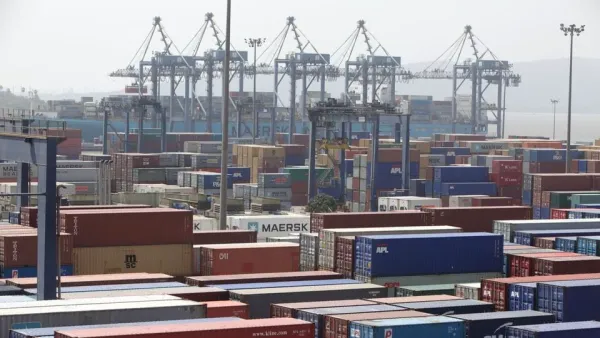Merchandise trade deficit in August was higher than economists' forecast of $25.13 billion in a Reuters poll.
Exports held up amid US tariffs that took effect in late August. Exports surged, driven by higher demand for engineering goods, electronic goods and drugs & pharma, among others.
In August, President Donald Trump announced an additional 25% tariff on Indian goods, reportedly linked to New Delhi's trade with Russia, bringing total levies on Indian exports to 50% - among the highest of any US trading partner. The new duties kicked in on 27 August.
About half of India's exports to the US could be affected, particularly labour-intensive sectors such as garments, leather, gems and jewellery. Exports to the US account for roughly 2% of India's GDP.
Merchandise exports fell sequentially to $35.10 billion in August from $37.24 billion in July, while imports fell more sharply to $61.59 billion from $64.59 billion during the same period.
A year ago, in August 2024, merchandise exports stood at $32.89 billion in value terms, while imports stood at $68.53 billion.
The combined trade in goods and services in August stood at $69.16 billion in exports and $79.04 billion in imports, raising the overall trade deficit to $9.88 billion for the month, lower than the $11.72 billion deficit in July and $21.73 billion a year ago.
Services exports remained largely steady at $34.06 billion in August, reporting lower than $31.03 billion in July, while services imports rose to $17.45 billion from $15.40 billion during the same period.
"Export strategy paying off"
Despite global headwinds, Indian exporters have held up remarkably well, reflecting the success of the government's export strategy, Union commerce secretary Sunil Barthwal said, briefing the media on the latest trade data.
He outlined four pillars underpinning India's export push: improving competitiveness, diversifying markets, reducing dependence on critical geographies and supply chains, and securing market access for key sectors.
"On competitiveness, initiatives like GST are helping exporters. Diversification is also visible as we tap new markets, which has strengthened resilience. At the same time, we are working to reduce reliance on a few geographies and build secure supply chains," Barthwal said.
He added that India has drawn up country-specific export strategies for about 50 markets that account for 90% of shipments, alongside sector-specific plans. Missions abroad, he said, have been tasked with implementing these strategies with equal vigor.
The commerce secretary also flagged efforts to cut India's import dependence. "We have identified around 100 products where domestic capacity exists. By boosting utilization, we can replace imports, strengthen industry, and reduce vulnerabilities," he said.
"Given this scenario, I am glad to say that our monthly exports, both merchandise and services, rose in August," Barthwal added.
Solid start
During April-August, the first five months of this financial year, merchandise exports rose 2.52% year-on-year to $184.13 billion, while imports climbed 2.14% to $306.52 billion.
Services exports rose 10.57% to $165.22 billion, while imports climbed 3.78% to $84.25 billion.
On the import side, petroleum and crude, electronic goods, and machinery remained the leading categories. China, Russia, the UAE, the US, and Saudi Arabia were India's top suppliers, while the US, UAE, the Netherlands, China, the UK, and Singapore remained the largest export destinations.
Non-petroleum exports during April-August reached $158.07 billion, up from $147.25 billion a year earlier, while non-petroleum imports rose to $228.43 billion from $221.97 billion.
Outlook: Exports on track
The global trade environment remains volatile.
Indian exporters are navigating challenges such as higher US tariffs on Indian goods and disruptions from geopolitical uncertainties. The Strait of Hormuz, a vital corridor for Indian energy and container shipments, has seen delays, adding to supply-chain stress in recent months.
The Export-Import Bank of India has projected that India's merchandise exports will reach $108.1 billion in the July-September fiscal second quarter, indicating that exports are likely to stay on track despite global uncertainties triggered by stiff US tariffs and trade tensions.
